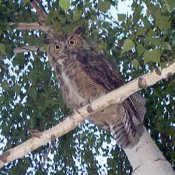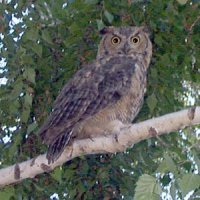Resource Cards

A great horned owl perches in a tree near an office building in the Tri-Cities.
![]()
![]()
If you are out walking along the Yakima River, Columbia River, or Yakima Delta, you might be fortunate enough to see a great horned owl perched in a cottonwood tree. You also might find them in daylight hours roosting in a rocky alcove. Great horned owls, sometimes called "cat owls" or "hoot owls," are the most widespread and commonly recognized owl. They are found throughout North and South America and are the largest owl found in the lower Columbia Basin.
What do great horned owls look like?
Great horned owls stand from 18 to 25 inches tall, and may have wingspans of 36 to 60 inches. These birds are big and bulky and can weigh from 3 to 4 pounds. Females birds are often larger than the males. Their plumage varies by region. In the Tri-Cities area, these owls are generally brown and have a white bib at the throat. You can easily recognize great horned owls by their large size and by the tufts of feathers atop their heads, which resemble horns. The name "horned" owl comes from the existence of these ear tufts. Great horned owls have large bright yellow-orange eyes. They also have an extra vertebrae in their necks that allows them to turn their heads 270 degrees. This is useful because their eyes are fixed. They have to turn their heads around to see up and down or side to side.
What do great horned owls sound like?
Great horned owls have a large repertoire of sounds, ranging from deep booming hoots to shrill shrieks. Both males and females hoot, but males have a lower pitched voice. The males "hoo-hoo hooooo hoo-hoo" may be heard over several miles during a still night. They often give a growling "krrooo-oo" or a screaming note when attacking intruders. They are also known to make a catlike "meee-owww", barks, hair-raising shrieks, coos, and snap their beaks. But don't expect to hear these owls call during the day. They're nocturnal. Most calling occurs from dusk to approximately midnight and just before dawn.

How do great horned owls live?
>Great horned owls are very adaptive. They inhabit nearly every type of terrain in North America from as low as sea level to as high as 11,000 feet. They can live in deep forests, deserts, and in suburban neighborhoods and parks. They do not build their own nests, but use the nests of other birds such as hawks, crows, eagles, and herons. They also may nest in squirrel nests, hollows in trees, rocky caves or ledges, and abandoned buildings. Nesting season is in January or February with eggs laid by March. Normally, two to four eggs are laid. Young owls are dependent on the adults throughout the summer and generally leave in the fall. Wild owls will live up to 13 years, whereas captive birds have been known to live 29 to 38 years. Great horned owls are considered to one of the most voracious of all raptors. They eat a wide variety of prey such as mice, rats, rabbits and birds, including gulls, crows, and great blue herons. They also will eat reptiles, large insects, fish and road kill as well as domestic cats and dogs. Great horned owls usually hunt by perching on snags or poles and watching for their prey, or by gliding slowly above the ground. Their prey is usually killed instantly when grasped by their large talons. Great horned owls can take prey two to three times as heavy as themselves.
![]() "Science is constructed of facts as a house is of stones. But a collection of facts is no more a science than a heap of stones is a house." Henri Poincare
"Science is constructed of facts as a house is of stones. But a collection of facts is no more a science than a heap of stones is a house." Henri Poincare
Keep in mind this fact sheet is intended to be used only as background information to support your effort to encourage inquiry-based science, which parallels the way scientists uncover knowledge and solve problems.

![]()
After researching and studying great horned owls, have the class design a web page to show off their class research. WebMonkey for Kids is an internet site that students can use to design a webpage. This site is very user friendly and has all the bells and whistles to make fantastic webpages. There is a fee to use this site.
As part of the class' study of great horned owls, the students can research what and how owls eat. The students will find that owls do not digest everything they eat. They spit up pellets, which contains bones and other parts of animals that they have eaten. The students can study the owl pellets to determine what the owls were eating. They can also use identification charts to determine what animals the owls have eaten. Owl pellets can be purchased from most science companies. Owl pellets and classroom owl pellet kits can be purchased online at http://www.owlpellets.com or http://www.pellet.com
![]()
- All About Owls, 1995. Jim Arnosky, Scholastic Trade, New York.
- Birds of the Tri-Cities and Vicinity, 1991. Howard R. Ennor, Lower Columbia Basin Audubon Society, Richland, Washington.
- Field Guide to Birds—Western Region, 1996. Donald and Lillian Stokes, Little, Brown and Company, New York.
- Owl Moon, 1987. Jane Yolen, Philomel Books, New York.
- The Book of North American Owls, 1995. Helen R. Sattler, Clarion Books, New York.
![]()
- Information on Owls - http://www-rci.rutgers.edu/~au/owl.htm
- Great Horned Owl—Bubo virginianus - http://www.owlpages.com/species/
bubo/virginianus/Default.htm - Great Horned Owls and Elementary Student Research Project - http://www.qesn.meq.gouv.qc.ca/schools/
pcartier/owlquest.ht - The Owl Pages - http://www.owlpages.com
- Enchanted Learning - http://www.enchantedlearning.com/subjects
/birds/printouts/Hornedowlprintout.shtml - Canadian Wildlife Service Great Horned Owls - http://www.hww.ca/index_e.asp
ID_species=17&lang=e - University of Michigan, Great Horned Owl - http://animaldiversity.ummz.umich.edu/
accounts/bubo/b._virginianus$narrative.html - Great Horned Owl - http://www.desertusa.com/mag00/jan/papr/ghowl.html
![]()
Initial development and printing was funded by the Partnership for Arid Land Stewardship (PALS). Project Manager: Karen Wieda. Written by: Mark Anderson, Prosser School District. Series Editor: Georganne O'Connor; Design: WinSome Design.
![]()
